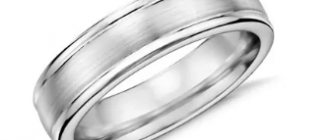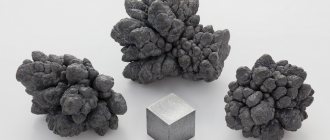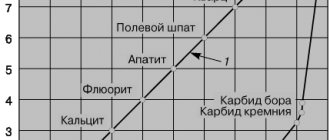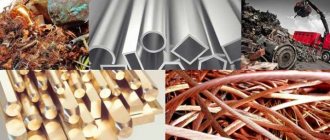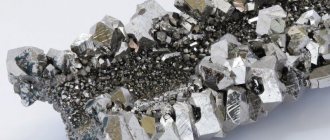Millions of years ago, our distant ancestors made their own tools from wood and stones, but thousands of years later they learned to use metals. From that moment on, humanity began to develop at an unimaginable pace and everything came to the point that most of the objects around us are made of iron, aluminum and other varieties of this material. Almost all metals conduct electricity and heat well, under certain conditions they are ductile and are excellent for making various electronic parts, and also have a characteristic metallic luster. But in the periodic table of Mendeleev there are metals that have unique properties that all others cannot boast of. They are amazing in their own way, and once upon a time these metals were considered to have almost magical qualities. So, let's list them and also learn about the properties and other interesting features?
Look around - we are surrounded by metals
The most liquid metal
Mercury is considered the most liquid metal and, at the same time, one of the most dangerous for the human body. It is almost always in a liquid state, because its melting point is -38 degrees Celsius. This is why this metal is used in thermometers - as the temperature increases, the liquid expands. Since the thermometer is made in the form of a glass tube, it can only expand in one direction. To prevent other conditions such as atmospheric pressure from affecting the thermometer readings, air is pumped out of the tube.
Despite its dangers, mercury is used even in everyday things
In the Middle Ages, it was believed that by mixing mercury, sulfur and the mysterious “philosopher’s stone”, pure gold could be obtained. Therefore, a lot of attention was paid to this metal. Since the Middle Ages, no one has been able to obtain gold from mercury, but scientists did it in 1947 - they placed 100 milligrams of mercury in a nuclear reactor and obtained 35 micrograms of gold. Here is the second amazing property of mercury - it can be turned into gold, but this is a very expensive process.
The most refractory metal
Now let's talk about the complete opposite of mercury - a metal called tungsten. While mercury can melt in the human palm, tungsten requires temperatures of 3,422 degrees Celsius to melt.
From German “Wolf Rahm” can be translated as “wolf cream”
Tungsten itself is not dangerous, but products that use it can kill. This metal is often used as the tip of ammunition, which can even penetrate body armor. Only a little bit of it is added, because tungsten is a very heavy metal.
In 2021, my colleague Ilya Khel wrote an interesting article about US Secret Weapons, where he reflected on what the American military might be hiding from us. I advise you to read it.
Due to its refractoriness, tungsten is difficult to deform, so it is used very rarely in its pure form. As a rule, tungsten products also contain other impurities - they make it more pliable and significantly reduce weight.
Iron
It is the most popular element of the transition group. An interesting fact about the metal: in ancient times, when humanity was not yet familiar with steel production technologies, iron was strengthened by firing in manure and flaps of leather, due to which the carbon enrichment of the material occurred and the strength significantly increased. Therefore, forges were often built near the stables.
It is impossible not to mention metal corrosion. An interesting fact: the fact that iron oxidizes when interacting with oxygen is primarily taken into account by astronauts when equipping the inventory compartment of a spacecraft. And it’s clear why! Indeed, in the vacuum of space, iron is not able to oxidize, and when it comes into contact with other metals, they literally stick together.
To avoid this problem, tools for working in outer space are wrapped in a special plastic base or subjected to oxidation on Earth.
The hardest metal
Titanium is considered the hardest and lightest metal on our planet. Due to its properties, it is actively used in aviation and shipbuilding - the material is excellent for the manufacture of aircraft and ship hulls. In addition, due to its strength and lightness, body armor is made from titanium. This metal is safe for the human body, therefore it is often used in medicine for the manufacture of instruments and even prostheses - artificial body parts.
Due to its outstanding properties, the word “titanium” is used to describe video cards and other electronics to emphasize their power.
When heated, titanium begins to absorb oxygen, chlorine, nitrogen and other gases. Thanks to this amazing property, the metal is used in various filters - passing various gases through titanium tubes heated to 600 degrees Celsius, you can clean them of impurities. In the same way, you can purify water from oxygen, which is especially useful in the food industry. It is believed that the oxygen contained in water degrades the quality of some products - at a minimum, it can shorten the shelf life of beer.
Alloys
Many of the metals we use today are alloys. Alloys are metals that combine two or more elements. They could also be called metallic compounds. Alloys are often stronger and harder than pure metal.
Steel is a very strong alloy. There are many steel alloys. The regular one is made of iron combined with a small amount of carbon. The stainless steel we use for cookware and kitchen appliances is steel with chromium added. Steel is used in many industries around the world.
Aluminum alloys are also very important. Aluminum is one of the most abundant elements on Earth. When combined with other elements such as copper and silicon, it can become a strong yet lightweight alloy. It also does not rust like many metals. Aluminum is used in a variety of items, such as airplanes, soda cans, ladders, and golf clubs.
[CHOSEN FOR YOU] Fantastic creatures that have been proven to be real
Aluminum
Bronze was one of the first alloys used to make tools. Bronze is a combination of copper and tin.
The most radioactive metal
The only metal that can be used as fuel in nuclear reactors is uranium. Many people consider it very dangerous due to its high radioactivity. However, natural uranium is safe for human health, but its variety called U-235, which is used in nuclear reactors, is dangerous.
Uranium-235 was used in the nuclear bombing of Hiroshima, in the "Baby" bomb
Once upon a time, dishes were even made from natural uranium. For example, fragments of yellow glass containing uranium were found in the Italian city of Naples - according to scientists, the glass was made in 79 AD. It was safe for people and no hints of radiation such as glow were observed.
Must read: What is a Tokamak? Just about the thermonuclear reactor
There is very little natural uranium U-235 suitable for use in nuclear reactors in nature today - over the years it has simply evaporated. But billions of years ago there was a lot of it, and nuclear reactions could be started right in nature, without human intervention. Thus, on the territory of the African country of Gabon, about 1.8 billion years ago, a natural fission reaction of uranium nuclei took place. Uranium burned for hundreds of years, but the reaction eventually stopped due to depletion of the metal.
Silver
Many people are familiar with the expression: “Silver is more valuable than gold.” It is not true. Nevertheless, this statement grows on the basis of the beneficial, healing, cleansing properties of silver. Water that has been in containers made of this material for a long time acquires anti-toxic properties. This explains the high popularity of silver utensils in the old days. For these reasons, silver water purifiers operate on modern space stations.
The first products made from this metal were discovered in Egypt, and they are more than 6 thousand years old. In modern India, it is customary to eat desserts covered with the thinnest silver foil, which helps maintain the health of the gastrointestinal tract in highly unsanitary conditions.
This metal is actively used by Asian manufacturers of thermoregulation equipment, mainly in the assembly of air conditioners with an air cleaning function.
In ancient times, silver served as a means of preventing lactic oxidation. A spoon made of this metal was placed in a jar with milk, due to which it did not oxidize for a long time. And finally, it stimulates the reproduction of hemoglobin and has a positive effect on the central nervous system. Such an amazing metal is silver. There are many more interesting facts about him, but these are the main ones.
The heaviest metal
Osmium is considered the heaviest metal from the entire periodic table. Its amazing property is that, being the heaviest, in air it becomes a volatile, toxic substance. The name “osmium” can be translated from ancient Greek as “smell”. This name was given to the metal for a reason - in 1803, the English chemist Smithson Tennant felt from his own experience that the metal smelled of chlorine and was so unpleasant that it irritated the throat.
Osmium, by the way, is very beautiful
Due to its hardness, osmium is often used in mechanisms, namely in places where strong friction occurs. It is also used in the manufacture of filaments for incandescent lamps. Poisonous properties occur only in open air - the metal turns into the toxic substance osmium tetroxide, which causes eye irritation, damage to the upper respiratory tract and even inflammation of the kidneys.
The most resistant metal
Iridium is considered the most resistant metal - it cannot be dissolved in any acid. Due to its durability, this metal is used by the International Bureau of Weights and Measures - the kilogram standard is created from it. This iridium cylinder is necessary so that all countries have a common idea of exactly how much a kilogram should weigh. This is important because any deviation can cause malfunctions in planes and ships and, subsequently, a serious disaster.
Iridium is an indicator of how much a kilogram should weigh
Iridium is also used in making money. For example, the African country of Rwanda issued an iridium coin with a face value of 10 Rwandan francs. We can say that this is the most chemical-resistant coin. The only way to damage it is by throwing it into a vessel with fluorine, a strong oxidizing agent. But the destructive reaction will begin only when heated to 450 degrees Celsius.
Interesting facts about metals (10 photos)
As everyone knows, progress does not stand still; it has also reached the metals industry. The sphere is endlessly expanding with more and more new alloys, which are actively used in industry, however, old varieties of metal elements are no less used in many areas.
But to carry out activities in the field of metallurgy: procurement, storage, processing of scrap non-ferrous and ferrous metals, a license for metals is required, the registration of which can be helped by financial and legal authorities, for more details see the link above.
1. One of the companies located in Switzerland is engaged in the production of bars from such types as gold, silver, palladium and platinum, but not in the classical form, but in such a way that it looks like chocolate.
2. Did you know that all the medals that are awarded to Olympic medalists are actually made of silver? So, in accordance with the recommendations of the IOC, all award products must be gold-plated in an amount of 6 g or more. But the medals awarded at the 2012 Olympics included only 1% gold.
3. It is noteworthy that there are alloys that have an interesting property - to remember their original appearance. We can see this type of alloy in nitinol, where 55% is nickel and 45% titanium. An exclusive structure called martensite, deformed during heating at a fairly high temperature, regains its original appearance.
4. How many of you paid attention to the edges of coins? Noticing very tiny slits there, you hardly thought that they had their own name - edge. These slots were nothing more than a method of combating scammers who tried to bypass the state and personally melt gold from crushed particles.
5. Over the entire period of existence, people were able to extract approximately 161 thousand tons of precious metal, the total cost of which was about 9 trillion. American dollars.
6. It has been proven that almost every hour an amount of iron is extracted from the bowels of the earth equal to the amount of gold mined over the entire period of human existence.
7. Interesting fact: All jewelry is made from gold, but with the addition of silver or copper. Without these constituent elements, the products would be very fragile and unusable.
8. Michel Lotito (an artist from France), became famous only because he swallowed objects that were not at all intended for internal consumption. According to eyewitnesses (participants in his show) during all his own performances, he swallowed about 9 tons of various metal alloys.
9. What do you know about the production of coins of the Russian Federation? Did you know that the price spent on their issue is slightly higher than the established denomination - for example, minting 5 kopecks. costs the state as much as 71 kopecks.
10. There was a time when such a precious metal as platinum was valued at almost two times lower than silver. It was also not particularly popular; low demand was explained by its refractoriness. The word platinum is translated from Spanish and is interpreted as “silver”. For quite a long time, this value eloquently reflected the very disdainful attitude of the local population towards this alloy. Nowadays, platinum products are valued more than silver.
11. In a small town in Japan - Suva, a very unusual method for extracting gold metal was found. By the way, it turned out to be 50 times better in terms of performance than the most elite gold mines from around the world. The precious metal is obtained from ash, which is a product of burning dry sewage residues. However, there are also some nuances here, for example, not every sewer is suitable for mining the alloy - in Suva there are a huge number of enterprises engaged in the production of electronics and using gold and gold-containing alloys in their work.
The most expensive metal
Many people invest in metals and one of the most expensive today is gold. At the exchange rate for June 2021, a gram of gold costs about 4,000 rubles, while the price of the same mass of platinum barely reaches 2,000 rubles. A little higher, we already found out that extracting gold from mercury is a very expensive process. Therefore, workers at refineries are engaged in obtaining gold - roughly speaking, they extract gold from mixtures of other metals.
Gold has been driving people crazy for thousands of years.
Since personnel work with very expensive metal, strict controls are in place in factories. If a person, for example, has a gold tooth, the guards always check whether it is in place. What if a person suddenly gets rid of a gold tooth and decides to bring in a piece of precious metal, placing it in the free space between the teeth? In some refineries, workers walk in naked and don work clothes inside.
Corrosion
This is a purely negative process, although it also has its advantages. Even 100 years ago, Caucasian horsemen realized the usefulness of the corrosion process for the production of durable, non-dull blades.
So, they were the first to bury their sabers and blades in the ground for a couple of years, where they acquired strength and the ability to cut even the hardest fibers. These characteristics of the metal were achieved due to the absorbent properties of rust, which, while in the ground, absorbed organic elements and carbon compounds.
The Indian engineering scientific community has come up with its own innovative method of protecting metal surfaces by catalyzing corrosion and then applying oxidized paint to the rusted surface. Thus, the special paint reacts with rust and forms a uniform, strong protective layer.
In the production of tools for cutting carcasses, alloys with a small percentage of chromium, copper and nickel are used, due to which the product is quickly covered with corrosion, under which over time a durable protective layer is formed that prevents further rust formation.
The rarest metal
Francium is the rarest metal. According to scientists' calculations, its concentration in the earth's crust is only 340 grams. It is possible to obtain more uranium artificially, but this requires starting nuclear reactions.
Francium is very rare and rarely used
Francium is very radioactive, so at the moment it is practically not used anywhere. However, sometimes scientists still use varieties of francium in the course of scientific research. There have also been attempts to diagnose cancer using technologies where francium was also involved.
If you are interested in science and technology news, subscribe to our Telegram channel. There you will find announcements of the latest news from our site!
The lightest metal
The title of lightest metal rightfully goes to lithium. It is painted silver-white and is so soft that it can be easily cut with a knife. Since it is the lightest metal on the periodic table, when it enters water it floats to the surface.
And here it is - lithium
For many, this may be a revelation, but you can hold a device with lithium in your hand right now - this is your smartphone. Mobile devices use lithium batteries, which are compact but only last a few days on a single charge. Scientists are trying to improve the performance of lithium-ion batteries, but so far they have not succeeded.
Perhaps in the future, completely different batteries will be used instead of lithium-ion batteries. Which? Read in this material.
Copper and cobalt
When listing interesting facts about metals in chemistry, it is worth mentioning these elements. Copper is of particular interest to vandals and non-ferrous metal hunters. It is found in transformer boxes, since copper elements are not capable of producing a spark.
But in the East, mainly in Japan, copper is used in fisheries as a substance that prevents the appearance of aquatic fungal diseases in water bodies.
And the emergence of cobalt is associated with Scandinavian mythology. Norwegian blacksmiths who smelted cobalt-containing minerals suffered arsenic poisoning. They explained the malaise and headache as the revenge of a mountain demon - Kobold, taking revenge on people for the destruction of his mines. This is how the name of this metal appeared. The origin of the name nickel is similar.
The most expensive industrial metal
Finally, it is worth mentioning californium, a metal that cannot be found in its pure form in nature. It is produced in nuclear reactors in Russia and the USA, and in very small quantities. According to scientists, in one year they manage to create only 40-80 micrograms of this unusual metal. Due to the difficulty of mining and rarity, a gram of this metal is worth up to $27 million.
Californian - a radioactive beauty
This metal is very radioactive, so you can’t make any crafts from it. But scientists need it during serious tests. Although, in theory, it can be used to create an atomic bomb. But the aforementioned uranium is much cheaper, so everyone uses it.
There are many more interesting elements in Mendeleev's periodic table, but these are, in my opinion, the most interesting metals. It is noteworthy that scientists are still developing metals with interesting properties. In 2021, my colleague Vladimir Kuznetsov talked about a material that does not sink in water - I recommend reading it!
Gold
Everyone knows that products made from this material combine prestige, sophistication and luxury. Gold jewelry makes a wonderful gift. But who would have thought that in Switzerland there are a number of companies producing fragmented chocolate-style bars from it that can be used as a gift? Or in settlement transactions. It is interesting that each tile consists of shares of 1 gram value and is easily divided into parts.
An interesting fact about the metal: as of 2014, approximately 179 tons of gold were mined worldwide, about half of which came from the Republic of South Africa. Almost the same amount of iron is mined from the bowels of the Earth every hour.
Gold is a very soft metal; for this reason, in the manufacture of jewelry, it is usually alloyed with impurities of copper or silver.

